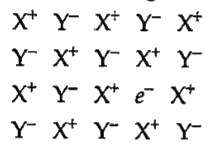Give an example of a compound in which hydrogen exists in (a) +1, (b) −1,
To solve the question of providing examples of compounds where hydrogen exists in the oxidation states of +1 and -1, we can follow these steps:
Step 1: Identify a compound where hydrogen has an oxidation state of +1.
- Example: Hydrochloric acid (HCl).
- In HCl, hydrogen is bonded to chlorine, which is more electronegative. The oxidation state of hydrogen in this compound is +1.
Step 2: Calculate the oxidation state of hydrogen in HCl.
- The oxidation state of chlorine (Cl) is -1.
- The overall charge of the compound is neutral (0).
- Therefore, we can set up the equation:
x+(−1)=0
where x is the oxidation state of hydrogen.
- Solving for x:
x=+1
- Thus, in HCl, hydrogen has an oxidation state of +1.
Step 3: Identify a compound where hydrogen has an oxidation state of -1.
- Example: Sodium hydride (NaH).
- In NaH, hydrogen is bonded to sodium, which is less electronegative. The oxidation state of hydrogen in this compound is -1.
Step 4: Calculate the oxidation state of hydrogen in NaH.
- The oxidation state of sodium (Na) is +1.
- The overall charge of the compound is neutral (0).
- Therefore, we can set up the equation:
+1+x=0
where x is the oxidation state of hydrogen.
- Solving for x:
x=−1
- Thus, in NaH, hydrogen has an oxidation state of -1.
Final Answer:
- A compound where hydrogen exists in the +1 oxidation state: HCl (Hydrochloric acid)
- A compound where hydrogen exists in the -1 oxidation state: NaH (Sodium hydride)
---
- Example: Hydrochloric acid (HCl).
- In HCl, hydrogen is bonded to chlorine, which is more electronegative. The oxidation state of hydrogen in this compound is +1.
- The oxidation state of chlorine (Cl) is -1.
- The overall charge of the compound is neutral (0).
- Therefore, we can set up the equation:
x+(−1)=0
where x is the oxidation state of hydrogen.
- Solving for x:
x=+1
- Thus, in HCl, hydrogen has an oxidation state of +1.
- Example: Sodium hydride (NaH).
- In NaH, hydrogen is bonded to sodium, which is less electronegative. The oxidation state of hydrogen in this compound is -1.
- The oxidation state of sodium (Na) is +1.
- The overall charge of the compound is neutral (0).
- Therefore, we can set up the equation:
+1+x=0
where x is the oxidation state of hydrogen.
- Solving for x:
x=−1
- Thus, in NaH, hydrogen has an oxidation state of -1.
- A compound where hydrogen exists in the +1 oxidation state: HCl (Hydrochloric acid)
- A compound where hydrogen exists in the -1 oxidation state: NaH (Sodium hydride)
Topper's Solved these Questions
- APPENDIX - INORGANIC VOLUME 1BOOK - CENGAGE CHEMISTRY ENGLISHCHAPTER - APPENDIX - INORGANIC VOLUME 1EXERCISE - chapter-2 Multiple correct answer
2 Videos
- APPENDIX - INORGANIC VOLUME 1BOOK - CENGAGE CHEMISTRY ENGLISHCHAPTER - APPENDIX - INORGANIC VOLUME 1EXERCISE - chapter-2 Single correct answer
3 Videos
- APPENDIX - INORGANIC VOLUME 1BOOK - CENGAGE CHEMISTRY ENGLISHCHAPTER - APPENDIX - INORGANIC VOLUME 1EXERCISE - Exercise very short
70 Videos
- ALKYNESBOOK - CENGAGE CHEMISTRY ENGLISHCHAPTER - ALKYNESEXERCISE - Exercises (Archives - Analytical and Desriptive Type)
4 Videos
- ATOMIC STRUCTUREBOOK - CENGAGE CHEMISTRY ENGLISHCHAPTER - ATOMIC STRUCTUREEXERCISE - Concept Applicationexercise(4.3)
19 Videos
Similar Questions
Knowledge Check
Examine the given defective crystal :

Answer the following questions:
Give an example of the compound which shows this type of defect.AStoichiometric, F-centre, KBrBNon-stoichiometric, holes, NaClCNon-stoichiometric, F-centre, LiClDStoichiometric, holes, KCI
Give an example of a compound in which hydrogen bonding results in the formation of a dimer.
View SolutionGive an example of compound which has pπ−dπ bonding?
View SolutionThe compound which does not exist as hydrate form
View SolutionThe pair of compound which cannot exist in solution is:
View SolutionGive two examples each of compounds existing in the following states :
(a) Solid (b) Liquid (c) Gaseous
View SolutionGive one example each of a fungus which reproduces by :
(a) building (b) conidia
View SolutionName one compound in which oxidation number of
(a) oxygen is +1
(b) oxygen is −1
(c ) hydrogen is −1
(d) nitrogen is +1
(e ) chlorine is +4
(f ) oxygen is −2
View Solution
